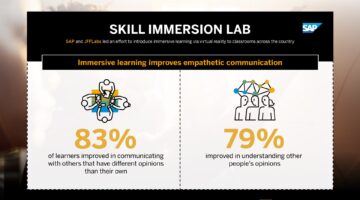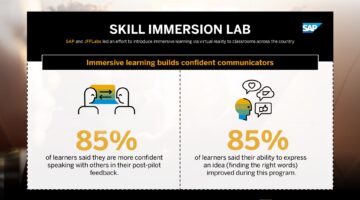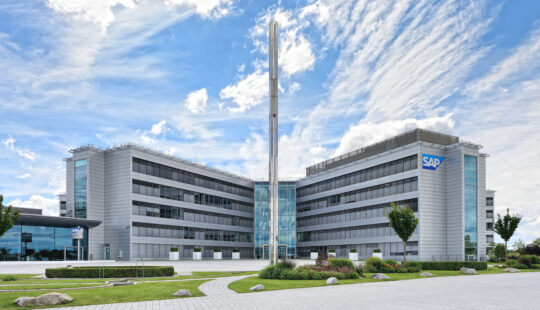When I reflect on my 25 years in the technology industry, a moment I often think back to is when I first arrived in Silicon Valley. After numerous rounds of interviews, I was hired into a role that provided the opportunity for a tremendous amount of growth, managing hundreds of people in the early years of the tech boom.
It was with the help of my manager — who would go on to become my mentor and lifelong friend — that I not only thrived in the role, but learned several invaluable skills, particularly around leadership and effective communication. The insights I gleaned in that first big role helped shape me into the leader I am today.
Just as I was able to in the early years of my career, SAP wants to ensure young learners have access to the tools to build critical early career skills. Soft skills have been and continue to be incredibly important; a 2021 survey by the National Association of Colleges and Employers, which looked at hiring projections for the class of 2021, found working in a team, communication, and leadership skills were more sought after than others like computer skills or even having a strong work ethic. We also know CEOs and hiring managers are finding these skills difficult to come by.
To help, SAP created a new program called the Skill Immersion Lab. At its core, this program uses virtual reality to teach students communication skills and effective leadership techniques.
To learn more about the Skill Immersion Lab and the results of its rollout, I sat down with Katie Booth, SAP North America’s head of Corporate Social Responsibility. Below is an edited version of our conversation.
Q: To get started, would you introduce yourself and share your role at SAP?
A: My name is Katie Booth and I oversee SAP’s North America Corporate Social Responsibility (CSR) program. We have three prominent focus areas in CSR: building digital skills, accelerating best run nonprofits and social enterprises, and connecting employees with purpose.
In practice, this means supporting and enabling our employees to give back in their local communities; working hand-in-hand with our amazing nonprofit partners, such as the Network for Teaching Entrepreneurship and GENYOUth; and building out programs for students that promote and improve technical know-how and digital literacy to better equip them for the future.
What is the Skill Immersion Lab and where was it launched?
The Skill Immersion Lab is a new program we launched in partnership with JFFLabs, a unit of JFF, a national nonprofit that works to drive transformation in the American workforce and education system. In short, our aim was to use virtual reality as an effective teaching tool. According to PwC, people who are taught using virtual reality technology are 3.75 times more emotionally connected to the content and four times more focused than their e-learning peers, which helps students improve their employability skills. We specifically wanted to work with learners in communities that do not typically get first access to technology like this.
The Skill Immersion Lab integrates immersive learning via virtual reality with instructor guidance and discussion. The curriculum was developed by spatial computing company Talespin.
In July we concluded the first round of learning with our community partners. It ran from four to six weeks, and we rolled it out at three locations across the U.S.: BTECH High School in New York City, Boys and Girls Club in St. Paul, and Quad YouthBuild in Louisiana. In all, about 50 learners aged 14 to 20 participated.
We chose these sites very intentionally. They’re in different and diverse parts of the country, ranging from urban to rural, and in different education programs and pathways. This meant learners with different backgrounds, experiences, and environments participated. We’ve known from the start that this program is centered on learner feedback, so a variety of learners is essential.
Why is there a need for a program like this?
We want to help young learners not only get jobs but have successful careers. Communication and durable, or “soft,” skills are crucial for both of these. We all know that. What’s interesting is how it seems these skills are becoming even more important.
The World Economic Forum, for example, published a study in October of last year in which it highlighted the top 15 skills employers see as increasing in demand by 2025. Among this list are skills like emotional intelligence, leadership and social influence, and persuasion and negotiation. PwC raises and interesting idea in the Workforce of the future study. The concept is that with automation replacing certain occupations, machines may in fact “amplify the comparative advantage” of workers that have strong skills like problem solving, leadership, emotional intelligence, empathy, and creativity. In short, soft skills may be future employees’ unique advantage.
We believe the Skill Immersion Lab serves a significant purpose in normal times, but might be critical during a pandemic, with the decrease in face-to-face communications and the rise of remote learning. McKinsey sites data from Curriculum Associates suggesting that only 60% of low-income students are consistently logging into online instruction compared to 90% of high-income students.
Nearly 90% of the learners said, in post-program feedback, that this technology was fun to use and that it was a more exciting way to learn. We believe this can play an important role not just in learning the content but also in retaining it—and our results did indicate this.
What does the curriculum structure focus on?
The immersive learning curriculum by Talespin is broken into two series: Leading Through Uncertainty and Effective Feedback.
Leading Through Uncertainty consists of five modules designed to empower leaders to apply and practice fundamental communication and interpersonal skills in difficult situations, in which the story line and skills build on top of each other. Effective Feedback includes three modules that provide an immersive learning experience for leaders and managers to further develop critical communication skills.
It’s important to state that this curriculum is not specifically designed for youth; this is a program built for mid- to high-level managers in a corporate setting, and we had students aged 14 to 20 years old using it to learn.
Now that the initial program results are rolling in, what did you learn?
We had a high degree of confidence that the outcomes would be broadly similar to what we see in adults with immersive technology, and we were right.
Our results showed that immersive learning helps build confident communicators. In post-program feedback, 85% of our learners said they are more confident speaking with others and an equal amount said their ability to express an idea improved during the program. We also found that it helped to improve empathetic communication. Seventy-nine percent of learners reported that they felt an improvement in their ability to understand others’ opinions and 83% felt an improvement with communicating with those with different opinions.
We also saw that virtual reality provided an optimal environment for fostering perseverance and resilience. Eighty-eight percent of learners agreed that when they had difficulty they kept trying. Our results showed that immersive learning provided formative feedback loops, facilitating deliberate practice in students. On average, our learners had a higher number of attempts on modules they received a below-acing score on in their first attempt. Also, 90% acknowledged that they went back to check their answers to see how they could improve when they finished a lesson.
Of course, this program was more than teaching students via virtual reality. We found that an effective approach was in the guided discussions instructors at each site facilitated. Our results indicated that this guidance was an influential factor in students learning the content. That is one unique element of this program: when students are going through the program, instructors play the role of a coach, while Talespin’s software acts more like the teacher and role play partner, offering students guidance, real-time feedback for skill development, and the opportunity to fail in a safe space and try again.
One instructor summed the typical student response as: “I never thought about other people’s feelings before or what they might be going through and how that could impact their work, but I do now.” Other success stories echoed this sentiment.
Was there anything that took you by surprise?
In some cases, yes. Probably most important is our goal to offer different program tracts to help learners achieve their goals. One site noted how much more impactful the program would have been if it had a customer service focus to it, since some of the students were in a customer service facing youth training program. The above data suggests that immersive learning is impactful, but a critical next step in scaling access to this technology is having different program tracts and customizable content. That’s something we’re currently looking into.
What’s next for the Skill Immersion Lab program?
We want to ensure we’re getting this technology into as many learners’ hands as possible. Virtual reality is not a new technology, but many people have not experienced it firsthand. I hope with this program we can begin to make the case for investing in this learning model, particularly in communities that may not have the resources to do so.
We’re looking at different models as we enter the second phase. We hope to develop models using what we’ve learned that can be more easily scaled, and I believe we’re nearing the turning point on that. That’s also one reason we’re publicly sharing these results, so others can follow in our footsteps. We need other organizations to step-up to the table and invest in this for their communities.
That’s our vision for the Skill Immersion Lab. It’s more than letting students play with innovative technology. It’s a road map for how innovation, multi-sector partnerships, and collaboration can support young learners. It’s an innovation intended to benefit all, not just those who can afford it.
Stephanie Nashawaty is chief customer innovation officer for SAP North America.





